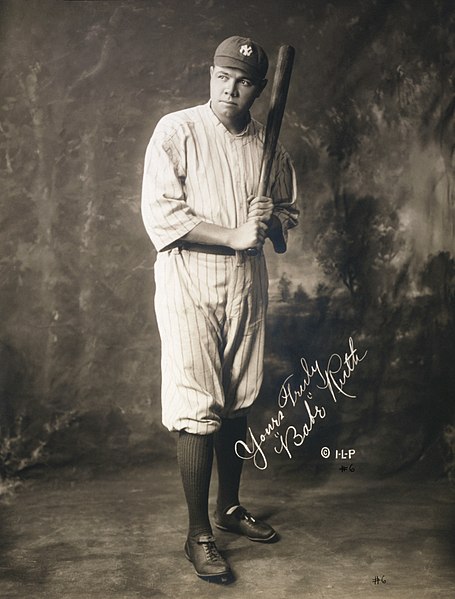Difference between revisions of "George Herman Ruth ("Babe") and Adoption"
(Created page with "{{#eimage: http://upload.wikimedia.org/wikipedia/commons/thumb/1/13/Babe_Ruth2.jpg/455px-Babe_Ruth2.jpg |410x579px|thumb|'''Babe Ruth 1920'''<br />Source: Wikipedia.org.}} ==B...") |
(No difference)
|
Revision as of 17:03, 23 April 2014
Biography
1895-1948
Athlete
Babe Ruth was the eldest of eight children born to a Baltimore bartender and his wife. They had no time for their son, and when he was seven they placed him in St. Mary's Industrial School for Boys, a combination orphanage and reform school. They even signed over custody to the Brothers who ran the institution. He had been virtually living on the streets already, and was classed as "incorrigible." There were no visits, but he did go back to live with his parents for short periods a couple of times.
Brother Mathais at St. Mary's took an interest in young George, and encouraged his obvious talent for baseball. He was spotted by a talent scout named Jack Dunn when he was 19, and in order to circumvent the custody order, which was supposed to last until he turned 21, Dunn became his legal guardian. His nickname was given him on an early appearance with the Baltimore Orioles. He was soon sold to the Boston Red Sox, and in 1919 to the New York Yankees, where he remained until 1934. For a few months after that he played for the Boston Braves, before retiring. He died from throat cancer in 1948. He was married twice. First to Helen Woodford, with whom he adopted a daughter, Dorothy. Helen died in a fire in 1929, and he married again four months later. His new wife, Claire Hodgson, a widow, also had a daughter, Julia, and they each adopted the other's child. Babe Ruth is still known as one of the best baseball players in history, and gave his name to a candy bar.
References
Stevens, Julia Ruth. "Babe Ruth.com." [Includes portraits]. Available at: [1] Stevens, Julia Ruth. A Father's Love: Babe Ruth's Daughter Remembers. (Chicago: Triumph Books, 2001) Gutelle, Andrew. Baseball's Best: Five True Stories. (New York: Random House, 2003) Miller, Ernestine G. The Babe Book: Baseball's Greatest Legend Remembered. (Kansas City, MO: Andrews McMell Pub., 2000)
- European
- USA
- 19th Century
- 20th Century
- Sports
- Adoptees/fosterees Who Are/were Also Adopters or Foster Parents
- School-age Years, Adolescence
- Child Abandoned or Rejected by Birth Parent(s)
- Priest, Religious, Teacher, Coach, Mentor, Patron, Apprentice Master or Owner
- Temporary Care
- Street Children, Children Who Grew up Without Adult Supervision (at Least Temporarily), or Ran Away
- Institutional Care
- Child in and out of Care
- Both Parents Unable or Unwilling to Care for Child
- Birth Sibling(s) Remained With or Returned to Birth Family
